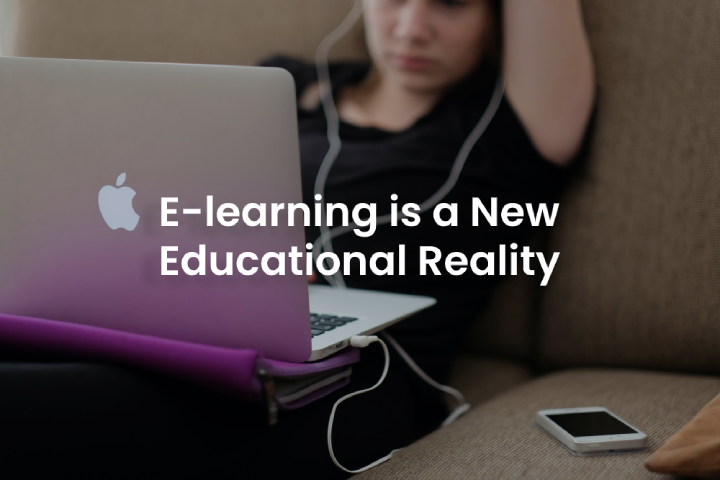Regulatory Decision-Making Solution for a Prominent Healthcare Provider
Navigating complex regulations with the decision-making solution in the healthcare industry is an important step for staying up-to-date and delivering …
 23 | 11 | 2020
23 | 11 | 2020 These days can be called the period of computer science and telecommunication boom. This is the era of online communication, active transfer of information and knowledge sharing. The notions of work and study have blended together: today, these two words have become almost synonymous; professional knowledge is getting outdated very quickly, so it is necessary to constantly update it. The world’s telecommunications infrastructure makes it possible to create systems of lifelong learning, general exchange of information, regardless of temporal and spatial zones. E-Learning as a model of education entered the XXI century (the very term was coined in 1999 by Elliot Masie) and has soon become the most effective system of training and continuous support of highly qualified specialists.
Over the past two decades, there has been a process of a smooth transition from traditional to computer-based learning. It was enabled mostly with the development of the Internet, which made it possible to send the required number of messages from one end of the world to the other, freely discuss issues with the users online and post information on Internet sites, thus making it available to everyone.
By the same token, modern information technologies make it possible to increase and improve the efficiency of the educational process while opening new vistas and becoming extremely in handy.
E-Learning statistics amazes: more than 20% of the US population has turned to online education in 2020 with even more of them having this shift planned in the nearest future. In its turn, the EU countries do not lag behind but use the e-Learning resources even more actively with almost 30% of them utilizing electronic technologies recently.
E-Learning domain is focused on the introduction into the educational process of fundamentally new learning models, which include conferences, independent work of students with information fields from different knowledge banks, project work, training and other activities based on computer technology. The source of information in these models is a database in a virtual learning environment.
The means of ensuring the use of all forms of interaction in this type of learning are modern information and telecommunication technologies, which allow students to join a variety of information sources independently. The most common means of organizing e-Learning today are tools based on Internet technologies, e.g. e-mailing, video conferencing, chats, forums, websites, online libraries, mailing files, etc.
Electronic learning is an ideal solution for those who prefer modern information technologies usage in learning to value their time and save money.
E-Learning is not only related to the education of students who are far outside the educational institution (distance students). Students of day and evening departments (local students) can also use the educational opportunities of the institution’s server. They, actually, work with the server remotely as well. Today, due to the high speed of information transfer in modern computer networks, the remoteness of the server has no impact on the very students. Therefore, when using computer technology, learning should not be divided into local or distance, taking into account the geographical distance only.

Currently, e-Learning is one of the world’s leading trends in education: this technology implements the principle of continuing education and is able to meet the growing demand for knowledge in the information society.
Yet, there definitely is another essential direction stimulus, which has given e-Learning considerable impulse for rapid development and increased demand. Sadly, but it is a Covid-19 global pandemic. Both pupils and students are forced to stay at their homes and study online. Understandably, many challenges have come to the surface, calling for additional time, skills and resources on both sides of the recipients and the providers of the educational process. This is where Information technology can serve best to assist in organization and support flows.
Computer-based learning undermines the use of computers during all types of classes and knowledge control, for individual learning as well as the development of intellectual and creative abilities of students.
The computer in the learning process is not only the object of study, it is used to support the educational and cognitive activities of the user.
Within the given notion, we can freely dwell on:
Computer technology has a wide range of tools for use in the educational process. All of them can be divided into three main categories, on the basis of which the whole e-Learning system is organized:
Electronic learning materials form the information content of the subject (e-content). These materials include:
Here we can mention content management system (CMS) as well, allowing us to create great e-Learning content if picked and used correctly (with WordPress at its heart). What is more, document management system (DMs) is based on Word, Excel, SharePoint depending on the type of documentation to store, share or find.
Computer test systems provide tools for:
Learning management systems (LMS) are designed to organize the learning process, namely:
Whatever system you would choose, each of them is aimed at easier accessibility for the learner. They are highly goal-oriented though. So choose the very data repository relevant for your target audience needs and interest coverage. Amidst all the LMSs, open-source systems stand out on the background. They are robust and multifunctional learning management systems beneficial for both educational and corporate establishments. The trick here is to choose a relevant consumer group and …go ahead.
Custom e-Learning software development for a variety of educational purposes is what the majority of IT companies have solid expertise in. To be more precise, there are usually offered services for a wide span of businesses, starting with teaching enterprises and ending with corporate training and alike. For instance, on the one hand, we have custom-designed educational and informational courses, web e-Learning platforms, e-Learning platform for the enterprise’s customers and staff development, the software development company Agiliway, among others, has been working out. On the other hand, there are microlearning and scenario learning as one of the most popular e-Learning modes to be developed and pursued.
Cloud-based technologies have appeared to be most functional while e-Learning engaged. Multifunctional web-application based on cloud technologies that provide students and teachers with a full range of opportunities for effective learning and collaboration. The platform is “armed” with a set of advanced digital tools that support all operating systems and client programs used by educational institutions in the country. Key areas are distance learning, a global communication panel, a combination of theoretical and interactive techniques and free access to all services. It is possible from any mobile or computer device, so the platform is recognized as a universal IT technology for work in the educational sector.
By the way, as we have mentioned mobile devices, it would be appropriate to stress the importance of mobile apps in e-Learning as a whole. 2008 witnessed the beginning of the mobile web with the appearance of smartphones, internet-enabled tablets, and alike. The world became mobile-enabled and gave birth to tech-savvy users. As we live in a society of millennials, our mobile phones have become integral components of our everyday life. According to the report reviews, the absolute majority of the modern population cannot do without their mobile gadgets even for an hour. Mobile technology solutions for e-Learning are numerous, top-notch and versatile. They are often free, exciting, user-friendly and flexible. Understandably, mobile apps will definitely revolutionize the world of electronic education. They have already started, indeed.
To summarize, one of the types of innovations in the organization of education is the introduction of e-learning. Unlike on-site learning, online learning provides the opportunity to learn at any distance from the school/university/training courses, etc. The idea of the electronic learning model is highly cost and time-efficient; the interaction of teacher and student takes place in cyberspace: they are both at their computers and communicate via the Internet. Understandably, an effective e-Learning process is possible due to top-notch information technologies with the IT sector being a driving force of its development, implementation and support aspects.
Navigating complex regulations with the decision-making solution in the healthcare industry is an important step for staying up-to-date and delivering …
Welcome back to the tech news rubric. This month’s tech news is bursting at the seams! We’ll explore the latest …
The travel industry has undergone a massive transformation in recent years, with travelers increasingly booking vacations and making travel arrangements …